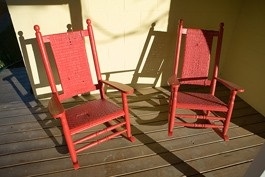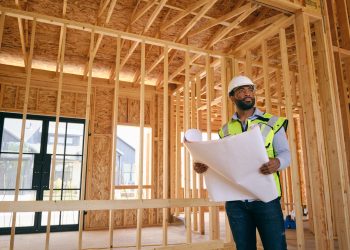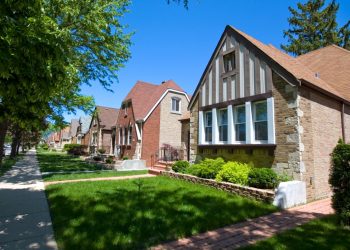 RISMEDIA, July 27, 2009-(MCT)-They had the land and the plan ready for a 3,000-square-foot retirement home.
RISMEDIA, July 27, 2009-(MCT)-They had the land and the plan ready for a 3,000-square-foot retirement home.
But sticker shock and a sour economy spurred Lee and Donna McCollough to downsize their dream into a 336-square-foot “country cabin.”
“It was mostly an economic move. But it’s serving our lifestyle very well,” said Lee McCollough of their home near Schulenburg in South Texas.
Built from vintage salvage materials by Tiny Texas Houses of Luling, McCollough said the “turnkey package” cost $70,000. “It’s great,” said the 62-year-old retired electrical technician. “People are impressed with the construction and coziness of it. It’s built like an Igloo ice chest.”
Tiny home proponents call it “super downsizing,” but that’s just the extreme edge of a growing movement away from suburban castles and into “right-sized” homes that require less energy, upkeep and money, experts say.
“The era of the ‘McMansion’ could well be over as home sizes have been trending downward recently, with a significantly higher number of architects reporting demand for smaller homes this year,” Kermit Baker, chief economist for the American Institute of Architects, said in a news release.
In a June survey by the National Association of Home Builders, 59% of respondents said they are building smaller homes, said Stephen Melman, the group’s director of economic services.
As the economy sank in 2008, new homes started shrinking, Melman said. Census data showed the average new home declined from 2,600 square feet in the second quarter of 2008 to 2,373 square feet in the third quarter, he said.
“This isn’t the worst thing in the world,” Melman said. “People are buying the home they need. Energy costs are up and people are interested in cutting costs.”
Brad Kittel of Tiny Texas Houses is addressing those needs. In 2006, he started the company to use materials from his salvage business. Using wood from old homes and barns, he built a 160-square-foot cottage to make a point. “I wanted people to understand that salvage antiques aren’t just for decoration. Once I built the first one, everybody liked it. It got a better response than I thought it would,” said Kittel. “I figured a 12-by-20-foot would be the biggest when I started, and now we are all the way up to a 12-by-33,” he said. “That might be too big.”
Kittel’s homes, which are built in Luling and trucked to home sites, drew initial interest as artist’s studios and weekend retreats. Now, the economy has people viewing them as full-time dwellings. Kittel has built about 30 of the petite abodes, and six more are in the works. They range in price from $38,000 to $90,000.
Kay Love was the first to call one home. Love, who owns a cattle company, has a 1,300-square-foot home in Austwell, Texas, but she wanted a second place near her family in Stockdale. Now she lives half the time in a 300-square-foot “Victorianish” home. “I planned to build a big house and then decided I didn’t need a big house,” she said. “I am real happy with it. I’m not environmentally correct, it just works for me. I had lived on a boat, so small things don’t really bother me. The house is comfortable; it sits in a pasture on the top of a hill with a nice view. It just fits.”
Kittel’s not the only builder squeezing into this tiny niche.
Jay Shafer, who has lived in a 100-square-foot home since 1999, has become a Pied Piper of the micro movement. Four years ago, the former art teacher and health food store clerk started Tumbleweed Tiny House Co. in Graton, Calif., which sells plans for small homes and builds tiny portable ones on wheels. He’s written The Small House Book and teaches courses on building small.
Interest in his homes is driven in equal measure by the economy and the environment, Shafer said. His home plans start at $995 and the houses on wheels run from $35,000 to $60,000. For such Spartan spaces, those prices sound steep but Shafer says building small is akin to “tailoring a suit.”
Kittel says it’s like “boat building considering the time and effort it takes.” The small houses take four to six months to build, he said. “It’s more labor-intensive because you are not using a 4-by-8-foot sheet of Sheetrock to cover the wall. Our cabinets are built into the house the old-fashioned way.”
And it’s not just small operators tapping into downsizing.
Lowe’s, the big-box home improvement retailer, sells kits and plans for Katrina Cottages, first designed as alternatives to the Federal Emergency Management Administration’s trailers.
“The program continues to draw interest from a variety of customers across the United States,” spokeswoman Maureen Rich wrote in an e-mail.
Minuscule homes aren’t for the material minded. “A guy came in and was talking about downsizing and he said what I’m doing is super downsizing,” Kittel said. “And admittedly, for most people it is that. If you are coming out of a conventional lifestyle with a 2,000-square-foot house and two people and you are moving into one of my houses, you are super downsizing.”
Shafer says getting rid of possessions takes an adjustment. “You look at what makes you happy and get rid of everything else,” he said. Besides, all that stuff is just an encumbrance.
Melman, of the home builders association, thinks downsizing is here to stay. “There’s a huge baby boom bulge coming out, and most of them are going to be empty nesters. They don’t need five bedrooms, they need two bedrooms,” he said.
The economy, energy prices and demographics are changing conceptions about housing, he said. “It’s becoming more of what you need. People are seriously considering a better fit.” That’s what Cheri and Scott Carpenter of Fort Worth are doing. They have one child and live in a 2,700-square-foot home but think that a house one-third smaller would simplify their life. “We talked about it and decided we had too much house. We like to take vacations and we would like to have less maintenance,” said Cheri, a literacy coach for the Fort Worth school district.
The McColloughs have moved in, but they still own a home in Dickinson so there’s some “super downsizing” to come. They do have a built-in fudge factor – a barn that serves as Lee’s shop and “man cave.” He admits that consolidating will be challenging. But so far, they aren’t feeling cramped. “The only problem is if we have six to eight people over its kind of small,” he said. “The impressive thing is that it will sleep six very comfortably. It has a separate bedroom, a kitchen and a full bath with a claw-foot tub. It’s not for a person that wants the great indoor space, it can cramp your style there,” he said. “We could live here forever.”
(c) 2009, Fort Worth Star-Telegram.
Distributed by McClatchy-Tribune Information Services.









